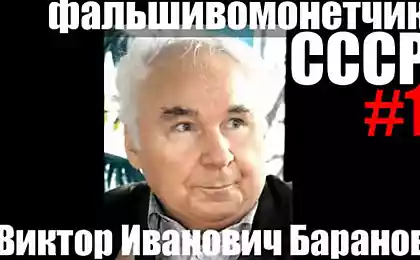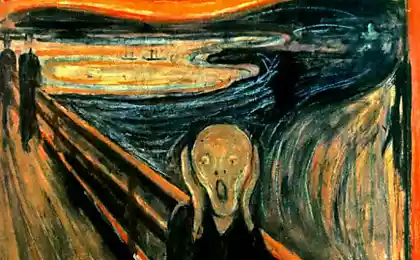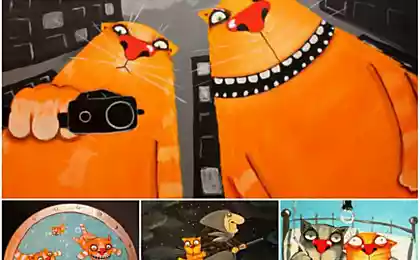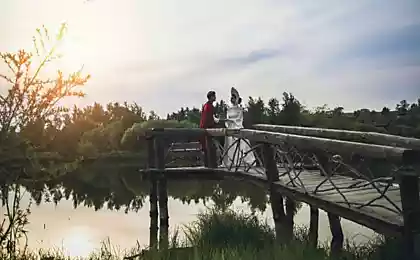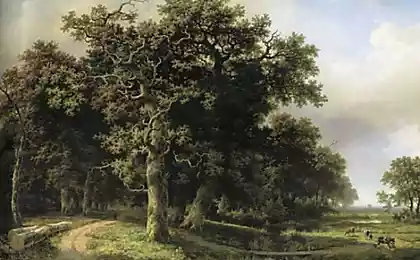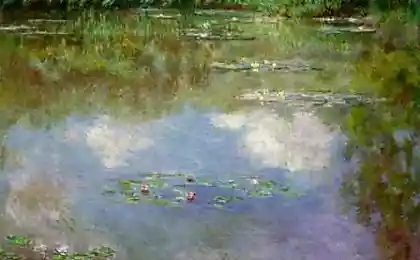1709
Russian painter Arkhip Kuindzhi
Riddles biography Kuinji begin from the date of his birth. The archives are kept just three of his passport, and which of them are the most genuine, it is not clear so far. In one of them mentioned the birth year of 1841, the second - 1842 m, and the third - 1843. The most likely date of birth - 1842. This conclusion incline documents issued at different times Kuinji uprava the city of Mariupol, where he was born, the Council of the Academy of Arts and other uchrezhdeniyami.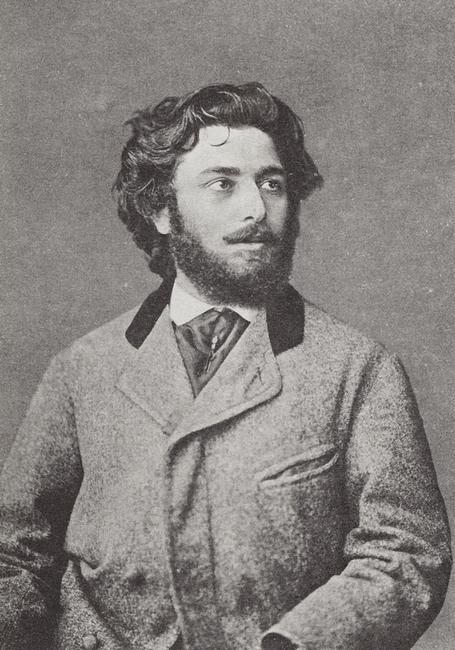
Antropov Kuindzhi, 1870.
Kuinji ancestors lived in the foothills of the Crimea near Bakhchisarai and engaged in arable farming. Greek Christian community, surrounded by settlements of Tatars, constantly feel their pressure. The Greeks were not Turkishized but many have learned the Tatar language and adopted Turkish names. Kuinji Turkish "goldsmith". Obviously, someone in his native Kuinji was a jeweler. In the metric he was listed under the name Emendzhi, which means "working man". The concept of "working man" is not at odds with the profession of his father Antropov - Ivan Khristoforovich, a shoemaker who was engaged to the same arable farming. AI Mendeleev recalls the words of the artist himself, though his name Shapovalov. This is probably the result of a misunderstanding. Shapovalov - maiden name of his wife Antropov, also bore the name Tatar Ketcherdzhi. Kuinji considered himself a Russian, their ancestors called Greeks who inhabited since antiquity, the Black Sea coast of the Crimea. They steadfastly maintained the Orthodox faith and culture of Turkish and Tatar conquest assimilyatsii.Posle Catherine II Tauris, some Greeks were resettled in the steppe river Kalchyk (Kalki), where once there was a fierce battle with the Russian Tatars. By the way, the relocation was entrusted to military units headed by AV Suvorov. So Kuinji ancestors were in the city of Pavlovsk, where the Greek colony existed since 1770. In 1780 Pavlovsk was renamed to Mariupol.
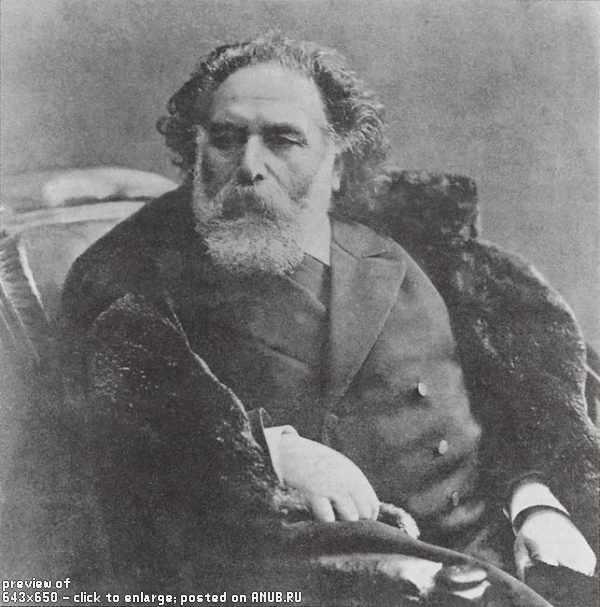
One of the last photos Kuinji
Ha share Arkhip Kuindzhi fell great fame and oblivion, wide popularity and misunderstanding. It seems that it is not praised for what he was great. And what he is remarkable in the life of Russian art is still appreciated not rated. Kuinji wrote about not too much. Word of mouth about his art is much broader study of his work. In books written about him more attracted the attention of his extraordinary personality, his biography unexpected than the originality and significance of his work. The originality of his life fate largely determined the character of its unusual art. And his fate was truly amazing.

Mendeleev and AIKuindzhi playing chess, 1907
Almost every picture Kuinji inflames passions: he was accused in the pursuit of cheap effects, the use of undercover techniques, such as covert illumination paintings. In the prime of his years, the artist suddenly abandoned the exhibition activity, fell silent for almost 30 years, but continued to work alone on new paintings. It is possible that the reason for this sudden and strange things began the most ambitious, unprecedented success that hit him a little earlier. And for fear of being crushed just this unnecessary fame, this noise and general worship, Kuinji decided to leave - leave undefeated. Kuinji days in its full force had disciples around him, but his coloristic gains have left their mark. Were it not for these gains, Russian art and, in particular, Russian landscape painters for a long time would not know what the paint and light, Russian artists continued to be just as shy and stupid to write off nature, as in the days Perov. Without Kuinji would not be what they were and two landscape genius 90s - Levitan, Serov. Subsequently Kuinji was invited to teach at the time was fast reformed Academy of Arts. Only here discovered what a wonderful artistic and pedagogical gift lived in this wizard. This gift, however, was a very simple but powerful features - it consisted only in the fact that Kuinji as a true artist, so passionately loved so deeply and understand the beauty of nature, that he should not have much difficulty to infect others with their passion is to share with others understanding. Under the direct influence Kuinji formed such outstanding masters as Roerich, K.Bogaevsky, A.Rylov. In 1909 Kuinji organized the Society of Artists, who bequeathed his paintings, money and land.
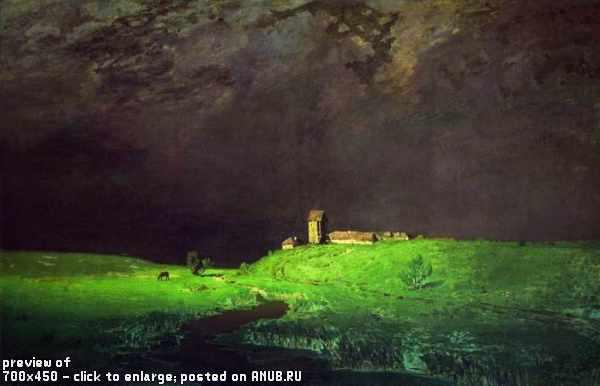
After the rain. 1879
Painting After the Rain typologically close romantic works. This is especially evident in the plot, sending a rapid state of nature, in an elevated psychologization landscape image, in the picturesque and freedom in a particular emotional importance attached texture painting. Nervous dynamic stroke, facilitates the transfer of rushing clouds, creates a complex structure of the web. At the same time, in the film there is no "romantic identity" between the author and the elements of nature. Kuinji not reveal their spiritual impulses, not subektiviziruet perception of thunderstorms swept, and tries to capture it in a real, objective quality. Lush green meadows written, snatched light. True tone green transitions from light to dark. Herbs prescribed white hut and purple stream, in order to withstand the color relationships in the plane of the web and does not interrupt his sharp color.

Ukrainian night. 1876
In 1876 Kuinji wrote this, impermissible luxury, Ukrainian night. Enthusiastic about her memories left Mikhail Nesterov: "Ukrainian Kuinji night before which was all the time a dense crowd quite affected by it and admiring spectators. She even in the distant least not then like a changed over many years oleograficheskuyu present a picture of this great master. " In Nesterovskoye statement is remarkable both. Citing a poem by Pushkin "Quiet Ukrainian night - transparent sky, the stars shine ..." Nesterov guess in light picture of Pushkin's poetry and poetry kuindzhievskuyu puts the level of Pushkin. In this canvas Kuinji artist finally won a moralist ...
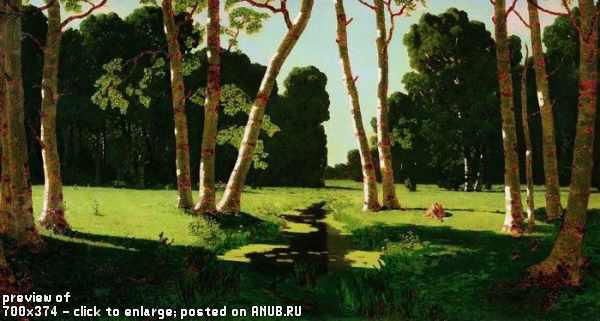
Birch Grove. 1879
One of the first designs of the painting could be a study in 1878 Pine forest with a river. Kuinji borrowed it from Shishkin composition close Ship grove. However, the interpretation of the landscape is another, devoid of epic Shishkin. In his study contained much of that foreshadowed birch grove. First of all - the motif of a creek, a generalization of tree crowns, deep space. In the picture is stored on the sketch reception cut the top edge of the image as a photo frame that gave a mean private. In the picture Birchwood Kuinji expands the plane of the sky and the dilution plans, in connection with which changes the interpretation of the landscape, striving to transmit light and joyful state of nature.

Ai-Petri. Crimea. 1898-1908

Dnepr in the morning. 1881

Red sunset. 1905-1908
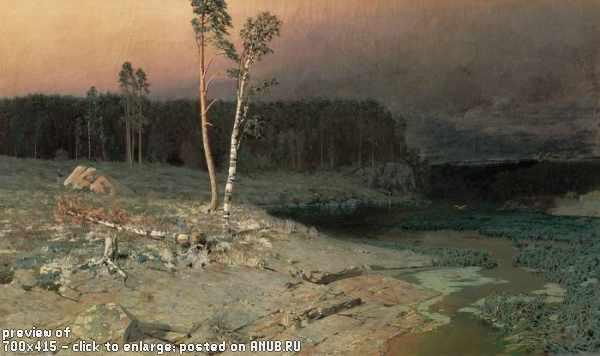
On the island of Valaam. 1873
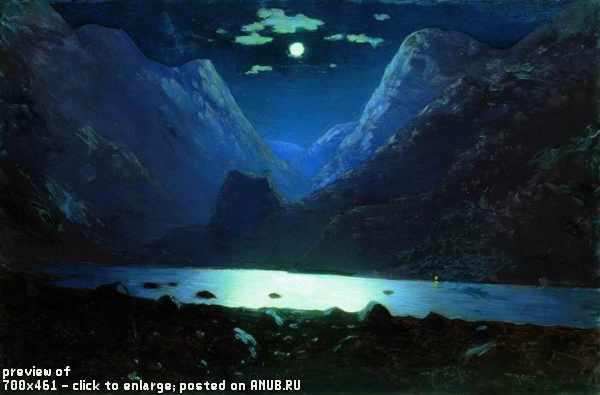
Daryal Gorge. Moonlit night. 1890-1895
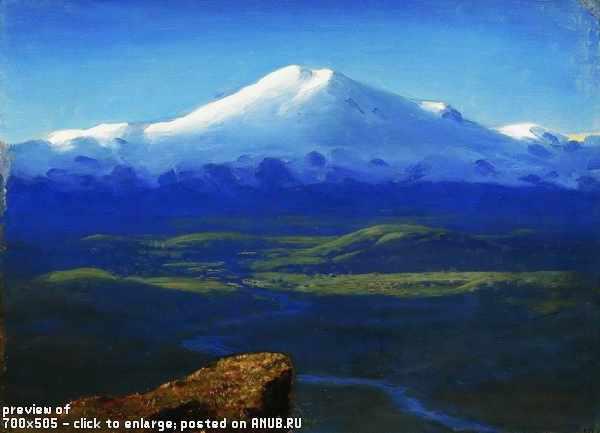
Snowy peaks. 1890-1895

Birch Grove. 1901

Moonlit Night on the Dnieper. 1880
In the summer and autumn of 1880, during a break from the Wanderers, AIKuindzhi working on a new painting. According to the Russian capital reverberated rumors of enchanting beauty of the "Moonlight Night on the Dnieper River." Two hours on Sundays artist wishing to open the door of his studio, and the St. Petersburg public began to besiege it long before the completion of the work. This painting has found a truly legendary fame. In the workshop AIKuindzhi came Turgenev and Ya.Polonsky, I.Kramskoy and P.Chistyakov, D.I.Mendelev, asked the price for the painting known publisher and collector K.T.Soldatenkov. Straight from the workshop, before the exhibition, "Moonlit Night on the Dnieper River" for a lot of money was bought by Grand Duke Konstantin Konstantinovich.
DV Sarabyanov marks a significant feature of romantic art of the 1880s - "romantic yearning." This is a valid observation allows us to associate creativity Kuinji and his German predecessor - Caspar David Friedrich. In the works of Friedrich people languish, spellbound contemplation of the face of a magical nature. It seems that the interpretation of the universe at Kuinji similar to Frederick. However, the resemblance is purely superficial. In the moonlit night on the Dnieper there is nothing magical, like Friedrich. Contemplation of celestial spaces in Kuinji experiencing gravity. Planetary distances conceptualized not abstract artist. Earthly world is perceived grandiose creation of nature, understanding that elevates man to lofty ideas. Magic zavorozhivaniya refers not to the mystic powers of the heavens, and to the great real world, to which a person experiences the wonder and delight.

North. 1879
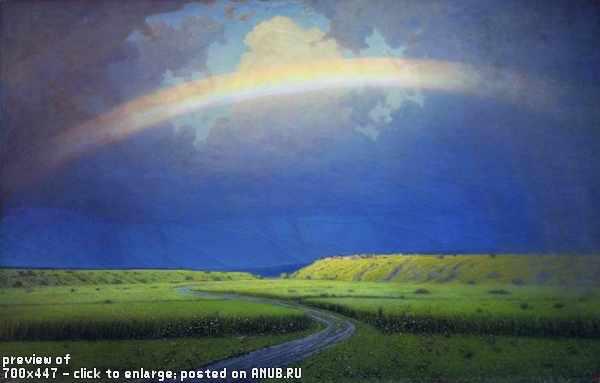
Rainbow. 1900-1905
For Russian painting had its appearance Monet - an artist who would have clearly understood the relationship of colors, so just be delving into their shades, so ardently and passionately wanted them to convey that and other Russian artists would believe him, would cease to apply to palette as some hardly necessary appendage. Paints in Russian art, from the time of Kiprenskii Venetsianov and ceased to play an independent, significant role. These artists themselves treated as a kind of formal suit, without which, just because of prejudice, indecent appear before the public.
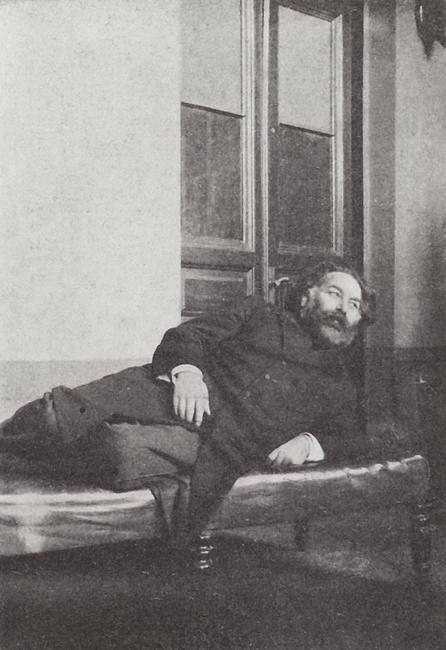
Antropov in the studio 1896
That's the main character trait Kuinji: he was kind. He loved birds. Every day at a certain hour he went out into the street with a bag of food, and the birds knew it. Once heard the traditional shot gun at Verka fortress who noted noon, clouds of birds flew almost from all over the city to the house on Sixth Line of Vasilievsky Island. In a small apartment Kuinji one of the rooms served as a bird infirmary - where he othazhivali sick and half frozen sparrows, crows and jackdaws in the cold winter months. He loved the people - and not just in words, but in deeds. "This ... this is what is? - He asked in Mariupol hot and melodious. - If I am rich, I am everything is possible: and eat and drink, and to learn, but if you have no money, it means - be hungry, sick and you can not learn how it was with me ... But I got his way, while others perish. So it's not that, it's necessary to fix it here so that was a lot of money and give to those in need, who are sick, who wants to learn ... ". Those were not empty words. It is impossible to truly understand the artist's paintings, not penetrating deeply into it as a man in his life, in his character, in his fate.
© kuinje.ru

Antropov Kuindzhi, 1870.
Kuinji ancestors lived in the foothills of the Crimea near Bakhchisarai and engaged in arable farming. Greek Christian community, surrounded by settlements of Tatars, constantly feel their pressure. The Greeks were not Turkishized but many have learned the Tatar language and adopted Turkish names. Kuinji Turkish "goldsmith". Obviously, someone in his native Kuinji was a jeweler. In the metric he was listed under the name Emendzhi, which means "working man". The concept of "working man" is not at odds with the profession of his father Antropov - Ivan Khristoforovich, a shoemaker who was engaged to the same arable farming. AI Mendeleev recalls the words of the artist himself, though his name Shapovalov. This is probably the result of a misunderstanding. Shapovalov - maiden name of his wife Antropov, also bore the name Tatar Ketcherdzhi. Kuinji considered himself a Russian, their ancestors called Greeks who inhabited since antiquity, the Black Sea coast of the Crimea. They steadfastly maintained the Orthodox faith and culture of Turkish and Tatar conquest assimilyatsii.Posle Catherine II Tauris, some Greeks were resettled in the steppe river Kalchyk (Kalki), where once there was a fierce battle with the Russian Tatars. By the way, the relocation was entrusted to military units headed by AV Suvorov. So Kuinji ancestors were in the city of Pavlovsk, where the Greek colony existed since 1770. In 1780 Pavlovsk was renamed to Mariupol.

One of the last photos Kuinji
Ha share Arkhip Kuindzhi fell great fame and oblivion, wide popularity and misunderstanding. It seems that it is not praised for what he was great. And what he is remarkable in the life of Russian art is still appreciated not rated. Kuinji wrote about not too much. Word of mouth about his art is much broader study of his work. In books written about him more attracted the attention of his extraordinary personality, his biography unexpected than the originality and significance of his work. The originality of his life fate largely determined the character of its unusual art. And his fate was truly amazing.

Mendeleev and AIKuindzhi playing chess, 1907
Almost every picture Kuinji inflames passions: he was accused in the pursuit of cheap effects, the use of undercover techniques, such as covert illumination paintings. In the prime of his years, the artist suddenly abandoned the exhibition activity, fell silent for almost 30 years, but continued to work alone on new paintings. It is possible that the reason for this sudden and strange things began the most ambitious, unprecedented success that hit him a little earlier. And for fear of being crushed just this unnecessary fame, this noise and general worship, Kuinji decided to leave - leave undefeated. Kuinji days in its full force had disciples around him, but his coloristic gains have left their mark. Were it not for these gains, Russian art and, in particular, Russian landscape painters for a long time would not know what the paint and light, Russian artists continued to be just as shy and stupid to write off nature, as in the days Perov. Without Kuinji would not be what they were and two landscape genius 90s - Levitan, Serov. Subsequently Kuinji was invited to teach at the time was fast reformed Academy of Arts. Only here discovered what a wonderful artistic and pedagogical gift lived in this wizard. This gift, however, was a very simple but powerful features - it consisted only in the fact that Kuinji as a true artist, so passionately loved so deeply and understand the beauty of nature, that he should not have much difficulty to infect others with their passion is to share with others understanding. Under the direct influence Kuinji formed such outstanding masters as Roerich, K.Bogaevsky, A.Rylov. In 1909 Kuinji organized the Society of Artists, who bequeathed his paintings, money and land.

After the rain. 1879
Painting After the Rain typologically close romantic works. This is especially evident in the plot, sending a rapid state of nature, in an elevated psychologization landscape image, in the picturesque and freedom in a particular emotional importance attached texture painting. Nervous dynamic stroke, facilitates the transfer of rushing clouds, creates a complex structure of the web. At the same time, in the film there is no "romantic identity" between the author and the elements of nature. Kuinji not reveal their spiritual impulses, not subektiviziruet perception of thunderstorms swept, and tries to capture it in a real, objective quality. Lush green meadows written, snatched light. True tone green transitions from light to dark. Herbs prescribed white hut and purple stream, in order to withstand the color relationships in the plane of the web and does not interrupt his sharp color.

Ukrainian night. 1876
In 1876 Kuinji wrote this, impermissible luxury, Ukrainian night. Enthusiastic about her memories left Mikhail Nesterov: "Ukrainian Kuinji night before which was all the time a dense crowd quite affected by it and admiring spectators. She even in the distant least not then like a changed over many years oleograficheskuyu present a picture of this great master. " In Nesterovskoye statement is remarkable both. Citing a poem by Pushkin "Quiet Ukrainian night - transparent sky, the stars shine ..." Nesterov guess in light picture of Pushkin's poetry and poetry kuindzhievskuyu puts the level of Pushkin. In this canvas Kuinji artist finally won a moralist ...

Birch Grove. 1879
One of the first designs of the painting could be a study in 1878 Pine forest with a river. Kuinji borrowed it from Shishkin composition close Ship grove. However, the interpretation of the landscape is another, devoid of epic Shishkin. In his study contained much of that foreshadowed birch grove. First of all - the motif of a creek, a generalization of tree crowns, deep space. In the picture is stored on the sketch reception cut the top edge of the image as a photo frame that gave a mean private. In the picture Birchwood Kuinji expands the plane of the sky and the dilution plans, in connection with which changes the interpretation of the landscape, striving to transmit light and joyful state of nature.

Ai-Petri. Crimea. 1898-1908

Dnepr in the morning. 1881

Red sunset. 1905-1908

On the island of Valaam. 1873

Daryal Gorge. Moonlit night. 1890-1895

Snowy peaks. 1890-1895

Birch Grove. 1901

Moonlit Night on the Dnieper. 1880
In the summer and autumn of 1880, during a break from the Wanderers, AIKuindzhi working on a new painting. According to the Russian capital reverberated rumors of enchanting beauty of the "Moonlight Night on the Dnieper River." Two hours on Sundays artist wishing to open the door of his studio, and the St. Petersburg public began to besiege it long before the completion of the work. This painting has found a truly legendary fame. In the workshop AIKuindzhi came Turgenev and Ya.Polonsky, I.Kramskoy and P.Chistyakov, D.I.Mendelev, asked the price for the painting known publisher and collector K.T.Soldatenkov. Straight from the workshop, before the exhibition, "Moonlit Night on the Dnieper River" for a lot of money was bought by Grand Duke Konstantin Konstantinovich.
DV Sarabyanov marks a significant feature of romantic art of the 1880s - "romantic yearning." This is a valid observation allows us to associate creativity Kuinji and his German predecessor - Caspar David Friedrich. In the works of Friedrich people languish, spellbound contemplation of the face of a magical nature. It seems that the interpretation of the universe at Kuinji similar to Frederick. However, the resemblance is purely superficial. In the moonlit night on the Dnieper there is nothing magical, like Friedrich. Contemplation of celestial spaces in Kuinji experiencing gravity. Planetary distances conceptualized not abstract artist. Earthly world is perceived grandiose creation of nature, understanding that elevates man to lofty ideas. Magic zavorozhivaniya refers not to the mystic powers of the heavens, and to the great real world, to which a person experiences the wonder and delight.

North. 1879

Rainbow. 1900-1905
For Russian painting had its appearance Monet - an artist who would have clearly understood the relationship of colors, so just be delving into their shades, so ardently and passionately wanted them to convey that and other Russian artists would believe him, would cease to apply to palette as some hardly necessary appendage. Paints in Russian art, from the time of Kiprenskii Venetsianov and ceased to play an independent, significant role. These artists themselves treated as a kind of formal suit, without which, just because of prejudice, indecent appear before the public.

Antropov in the studio 1896
That's the main character trait Kuinji: he was kind. He loved birds. Every day at a certain hour he went out into the street with a bag of food, and the birds knew it. Once heard the traditional shot gun at Verka fortress who noted noon, clouds of birds flew almost from all over the city to the house on Sixth Line of Vasilievsky Island. In a small apartment Kuinji one of the rooms served as a bird infirmary - where he othazhivali sick and half frozen sparrows, crows and jackdaws in the cold winter months. He loved the people - and not just in words, but in deeds. "This ... this is what is? - He asked in Mariupol hot and melodious. - If I am rich, I am everything is possible: and eat and drink, and to learn, but if you have no money, it means - be hungry, sick and you can not learn how it was with me ... But I got his way, while others perish. So it's not that, it's necessary to fix it here so that was a lot of money and give to those in need, who are sick, who wants to learn ... ". Those were not empty words. It is impossible to truly understand the artist's paintings, not penetrating deeply into it as a man in his life, in his character, in his fate.
© kuinje.ru





